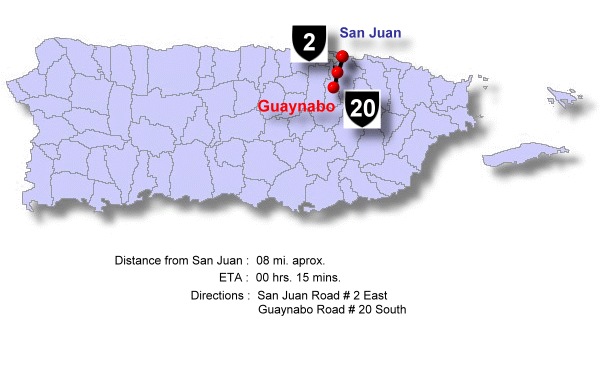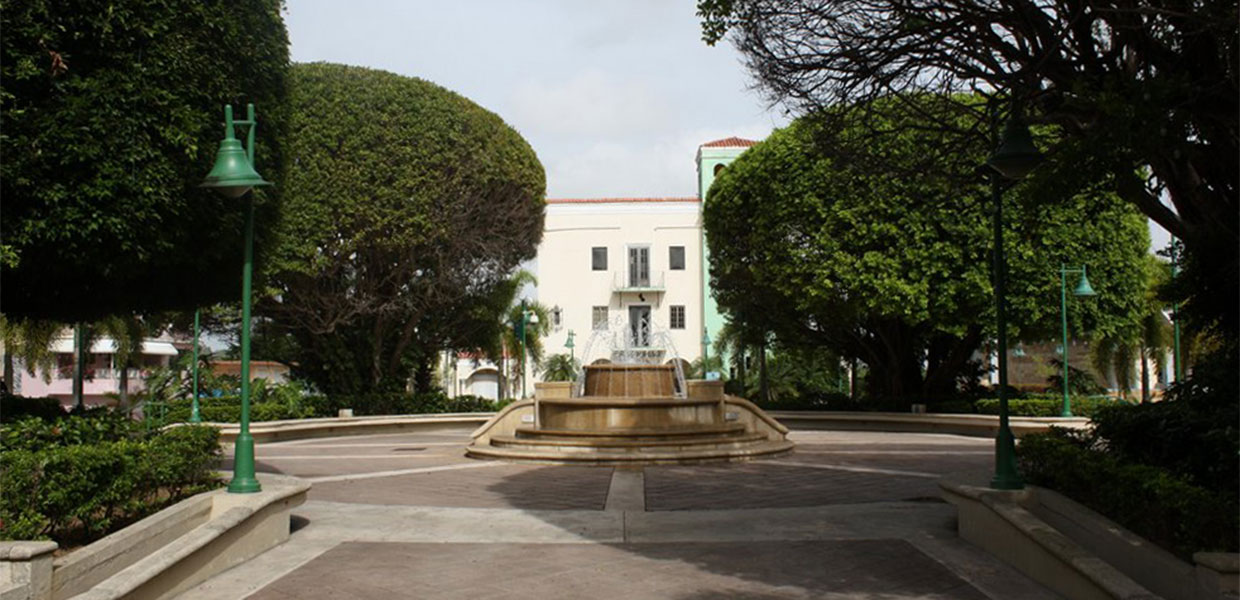
Guaynabo, Puerto Rico
Puerto Rico's First Settlement
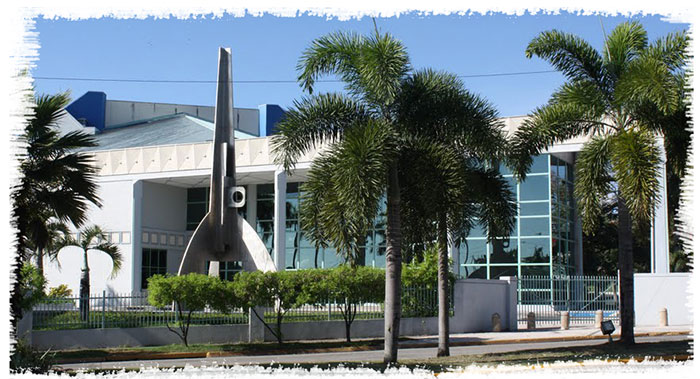
Guaynabo (gwei-NAH-bo) is known as the “first settlement of Puerto Rico,” “the city of the conquistadors,” “the capital of sports,” “the ruins of Caparra,” and “the town of the Mabó Carnival.” Its patron saint is Saint Peter Martyr of Verona.
This municipality is located on the northern coast of the island. It is bordered to the north by the town of Cataño and the San Juan Bay; to the south by Aguas Buenas; to the east by San Juan; and to the west by Bayamón. The terrain is mostly flat and humid.
The relief of its territory can be divided into three areas. The first covers the northern area and belongs to the region known as the Northern Coastal Plains. Towards the center of the municipality, several mogotes (isolated hills) can be observed. Finally, Guaynabo has a mountainous zone in its southern area.
The economy of this municipality is mainly industrial and commercial. Its notable factories include those producing dairy products, wheat, and other grains, as well as manufacturing of metal, paper, textiles, and chemical products. Other economic sectors include services and construction.
Foundation
Guaynabo was founded in 1769 after its founders fought to separate from Bayamón. On December 14, 1764, approval was granted to establish the town. Previously, the city of Guaynabo was known as Buinabo. The Taíno name Guaynabo means “Here is another place of fresh water,” and it was the domain of the Cacique Mabó.
The colonization process began in 1508 when Juan Ponce de León, appointed Captain General of Land and Sea in 1509 and Governor in 1510, founded Caparra, the first Spanish settlement on the island, located in the north of what is now the municipality of Guaynabo.
The town of Guaynabo was founded in 1723 and elevated to the status of a municipality in 1769, separating from the municipality of Río Piedras. In 1875, the municipality was dissolved, and its territory divided between Bayamón and Río Piedras; the town remained within the municipality of Bayamón. Later, in 1912, Guaynabo regained its status as a municipality.
Location
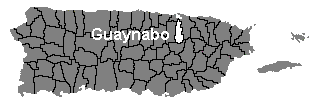 Located in the northern coast, it is bordereded by: Cataño and the San Juan Bay to the north, Aguas Buenas to the south, Bayamón to the west, and San Juan to the east.
Located in the northern coast, it is bordereded by: Cataño and the San Juan Bay to the north, Aguas Buenas to the south, Bayamón to the west, and San Juan to the east.
Area
70.2 km² / 27.0 mi²
Population
2023 Census – 70,087 inhabitants
Population Density
~999 inhabitants per square kilometer / ~2,595 inhabitants per square mile
People are known as:
Guaynabeños
Nicknames
Primer Poblado de Puerto Rico (First Settlement of Puerto Rico)
Guaynabo la Ciudad de los Conquistadores (Guaynabo, the City of Conquistadors)
El Pueblo del Carnaval Mabó (The Town of the Mabó Carnival)
Wards: Guaynabo, Puerto Rico
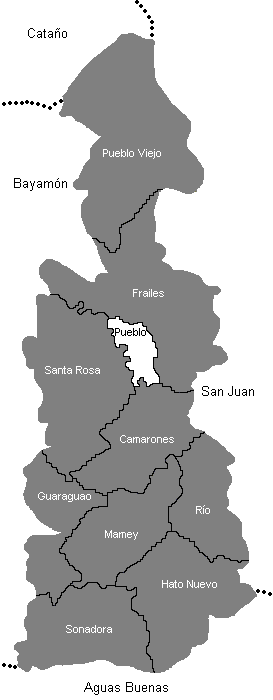
| Censo 2023: Estimated Population - Guaynabo |
Estimated Population |
| Camarones | 4,919 |
| Frailes | 33,023 |
| Guaraguao | 4,145 |
| Guaynabo Pueblo | 3,579 |
| Hato Nuevo | 4,300 |
| Mamey | 3,165 |
| Pueblo Viejo | 26,109 |
| Río | 2,427 |
| Santa Rosa | 15,927 |
| Sonadora | 1,337 |
| Total | 70,087 |
Source: 2023 Census
Patron:
San Pedro Mártir de Verona
San Pedro Mártir de Verona Parish
PO Box 32 Guaynabo, PR 00970-0032
Tel. 787 720 2361
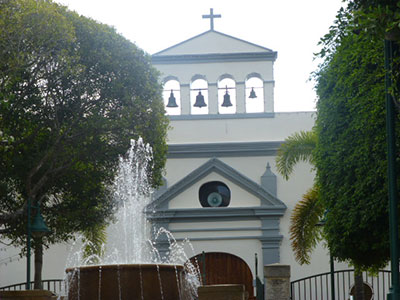
Topography
To the south it contains smooth hills, the rest of its territory is characteristic of the Northern Coastal Plain.
Guaynabo has varied terrain combining flat and mountainous areas:
- Southern Zone: Gentle hills and small mountains that are part of the Sierra de Luquillo, with elevations reaching up to 300 meters (984 feet) above sea level in some areas. These areas include secondary forests and protected green spaces.
- Central Zone: Dominated by isolated mogotes and low hills that aid natural water runoff and define barrio boundaries.
- Northern Zone: The Northern Coastal Plains extend across this area, characterized by flat, humid land ideal for urbanization, commerce, and industry. This terrain facilitates the construction of roads and residential infrastructure but requires efficient drainage systems due to frequent tropical rains.
Seismicity and Geology: Guaynabo is located on alluvial soils and sedimentary rocks, with moderate seismic activity, similar to the rest of the San Juan metropolitan area.
Hydrography
Guaynabo is watered by the Bayamón River and the Guaynabo River, the largest tributary of the Bayamón River, which originates in the Mamey barrio.
- Bayamón River: Main river bordering the municipality to the west, contributing to drainage in the metropolitan area.
- Guaynabo River: Largest tributary of the Bayamón River, originating in Mamey and flowing approximately 15 km (9.3 mi) before joining the Bayamón River. Historically, it has been a source of water and energy for the region.
- Streams and Creeks: Smaller tributaries, such as Arroyo Frailes and Arroyo Hato Nuevo, cross residential and commercial areas, helping prevent flooding.
- Dams and Reservoirs: Small dams and retention systems in the south help control water flow and reduce overflow risks during the rainy season and hurricanes.
Urban Impact: Population growth and urban expansion have required flood mitigation programs and riverbank restoration to protect neighborhoods and commercial areas.
Economy
Commerce, manufacturing (nutritional products and apparel).
Guaynabo has a diverse water system that has been key to its urban and industrial development:
- Manufacturing: Dairy products, wheat, grains, metal, paper, textiles, and chemicals.
- Commerce and Services: Shopping centers, restaurants, and professional service companies.
- Construction: Residential and commercial projects, including gated communities.
Transportation
- Urban Train: Connects Guaynabo with San Juan and Bayamón, providing access to commercial and work areas.
- Municipal Buses: Public transportation covers barrios such as Camarones, Mamey, Guaraguao, and Hato Nuevo, Monday to Friday from 6:00 AM to 5:00 PM and Saturdays from 8:00 AM to 4:00 PM.
- Private Transport Services: Companies like Puerto Rico Green Transportation offer eco-friendly and personalized transportation services in the region.
Infrastructure and Urban Development
Guaynabo has experienced significant growth and urban development in recent decades, especially in:
- Housing and Gated Communities: Numerous private residential communities provide security and exclusive services.
- Commerce and Services: Guaynabo is an important commercial hub with shopping centers, restaurants, and services attracting residents and visitors alike.
- Infrastructure Projects: Ongoing projects aim to improve roads and transport infrastructure, facilitating mobility and enhancing residents’ quality of life.
Culture and Recreation
Guaynabo is known for its rich cultural and recreational life:
- Cultural Events: The municipality organizes festivals and cultural activities throughout the year, including the Mabó Carnival and the Patron Saint Festivities of San Pedro Martyr.
- Sports Facilities: Top-level sports facilities, including stadiums, tennis courts, and recreational centers, encourage physical activity and sports among residents.
- Recreational Spaces: Parks and recreational areas allow residents to enjoy outdoor activities and community events.
Flag:
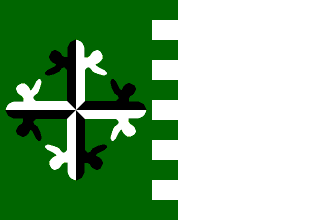 The official flag of Guaynabo was adopted in 1972 and consists of a vertically divided field separated by a battlemented line. The colors and elements carry deep historical and symbolic meaning:
The official flag of Guaynabo was adopted in 1972 and consists of a vertically divided field separated by a battlemented line. The colors and elements carry deep historical and symbolic meaning:
Colors:
- Green (vert): Represents fertility, hope, and abundance in the region.
- White (argent): Symbolizes purity, peace, and unity of the people of Guaynabo.
- Black (sable): Signifies strength, stability, and formality of the community.
Heraldic Elements:
- Flory cross and triangular divisions: Located on the green section, this cross is a religious symbol representing Saint Peter Martyr of Verona, the patron of Guaynabo. The cross is divided by a vertical line, a horizontal line, and two diagonals, alternating silver and black colors, reflecting the influence of the Dominican Order of Preachers. Its design also recalls the structure of the Casa Fuerte de Caparra, the residence of Juan Ponce de León, the first governor of Puerto Rico.
- Battlements: On the white section, six green and five opposing white battlements evoke the defensive walls of the old Caparra fortress and highlight the historical importance of the municipality in the island’s colonization.
Coat of Arms of Guaynabo
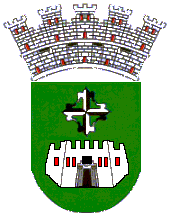 The coat of arms of Guaynabo was officially adopted in 1972 as a heraldic symbol representing the municipality’s rich history, culture, and values. Its design resulted from a collaborative effort between the Puerto Rican Institute of Culture and the Junior Chamber of Guaynabo. The municipal assembly approved the coat of arms on July 11, 1972, during the mayoralty of Santos Rivera Pérez.
The coat of arms of Guaynabo was officially adopted in 1972 as a heraldic symbol representing the municipality’s rich history, culture, and values. Its design resulted from a collaborative effort between the Puerto Rican Institute of Culture and the Junior Chamber of Guaynabo. The municipal assembly approved the coat of arms on July 11, 1972, during the mayoralty of Santos Rivera Pérez.
Heraldic Description:
"On a green field (vert), in chief a flory cross divided in silver and black (argent and sable). In base, a masonry fortress in red (gules) with a silver escutcheon over its door, bearing a purple rampant lion. The shield is topped with a mural crown of five towers, masoned and highlighted in green (vert)."
Symbolic Elements:
- Flory cross: At the top, representing Saint Peter Martyr of Verona and the Dominican Order. Silver and black alternate to symbolize purity, peace, strength, and stability.
- Masonry fortress in red: Represents the town of Caparra, the first capital of Puerto Rico, and Juan Ponce de León’s residence, which served as both home and the first municipal council seat. Red symbolizes courage and sacrifice.
- Escutcheon with purple rampant lion: Above the fortress door, this represents the Ponce de León family, highlighting Juan Ponce de León’s heritage.
- Mural crown of five towers: Denotes Guaynabo’s city status and autonomy as a municipality.
Events in Guaynabo
Guaynabo stands out for its cultural, sports, and recreational offerings, hosting celebrations that attract residents and visitors from across Puerto Rico:
- Three Kings’ Celebration (January): Traditional Puerto Rican festivities with children’s activities, music, and gift-giving.
- Mabó Carnival (February): One of Puerto Rico’s most famous carnivals with parades, floats, carnival queens, colorful costumes, and live music.
- Mother’s Day Tribute (May): Artistic and cultural activities honoring mothers of Guaynabo.
- Patron Saint Festivities of San Pedro Martyr of Verona (May): Includes masses, processions, music, fairs, and cultural presentations.
- National Salsa Day (June): Large-scale event sometimes held in Guaynabo, featuring major salsa performers.
- Classic and Antique Car Fair (June): Exhibitions of classic and collector cars popular with enthusiasts.
- Fine Arts, Recreation, and Sports Camp (June–July): Municipal initiative for children and youth promoting creativity, music, art, sports, and recreation.
- Santa Rosa de Lima Festival (August): Religious and cultural celebration dedicated to the Peruvian saint, rooted in the municipality’s Catholic tradition
- Cycling Classic (September): Sports competition through various streets and avenues promoting physical activity.
- Bomba and Plena Festival “Pa’ la Costa de Guaynabo” (October): Musical event highlighting Afro-Caribbean traditions with workshops, dances, and performances.
- Christmas Lighting “Enchanted City” (November): One of the most anticipated celebrations with city lighting, carols, musical shows, and family activities.
- International Sports Events: Guaynabo has hosted national and international volleyball, basketball, and boxing tournaments thanks to its sports infrastructure.
Places of Interest in Guaynabo
Guaynabo combines history, culture, and modernity with its landmarks:
- Old City Hall: Historic seat of municipal government.
- Old Telegraph: Monument commemorating the beginnings of telecommunications.
- Bust of Román Baldorioty de Castro: Tribute to the educator and abolitionist leader.
- Modern City Hall: Current administrative building.
- Alejandro Cruz Ortiz Fine Arts Center: Major cultural venue hosting concerts, theater, and artistic performances.
- Caribbean Recreational Center: Recreational and social complex.
- Frailes Sports Complex: Includes Donna Terry and José Bonano stadiums, courts, and the Puerto Rico Sports Museum.
- San Pedro Martyr of Verona Church: Catholic church honoring the patron saint.
- Mets Pavilion (Mets Stadium): Sports facility for baseball and other events.
- Gavillán Lookout: Scenic point with views of the metropolitan area and northern coast.
- Puerto Rico Sports Museum: Exhibits memorabilia of athletes and iconic Puerto Rican sports.
- Caparra Ruins Museum and Historical Park: Archaeological site of Puerto Rico’s first capital, founded by Juan Ponce de León in 1508; a national historic monument.
- Plaza de los Artistas: Cultural and community gathering space.
- Town Square (Plaza de Recreo): Heart of the town hosting events and activities.
- Rafael Martínez Nadal Residence: Historic home of the former Senate president.
- Vórtice II (Plaza de la Cultura): Sculptural work and cultural space.
- Modern Shopping Centers: Including San Patricio Plaza, one of Puerto Rico’s most important malls.
Notable People from Guaynabo
- Román Baldorioty de Castro (1822–1889): Educator, writer, and abolitionist leader; founder of the Puerto Rican Autonomist Party; represented Puerto Rico at the 1867 Paris Universal Exposition; deputy to the Cortes in 1870.
- Rafael Martínez Nadal (1877–1941): Lawyer, journalist, and politician; President of the Senate of Puerto Rico (1933–1941); leader of the Pure Republican Party.
- Dolores Valdivieso Llompart: First woman to serve as mayor of Guaynabo; pioneer in women’s political participation.
- Alejandro Cruz Ortiz: Prominent cultural promoter; the Fine Arts Center bears his name.
- Notable Athletes: Guaynabo has produced high-performance athletes in baseball, volleyball, and boxing who have represented Puerto Rico internationally.
Public Schools sorted by educational levels.
Bayamón Region
Guayanabo District
| Name | Level | Telephone | Address |
| Elementary | |||
| MARIANO ABRIL | K-6 | (787) 720-7870 | PO Box 29030-441, P.R. 00725-8900 |
| LUIS MUÑOZ RIVERA I | K-3 | (787) 783-8920 | PO Box 3429, P.R. 00963-0000 |
| ALEJANDRO JR. CRUZ | K-6 | (787) 287-6080 | PO Box 939, P.R. 00970-9390 |
| BETTY ROSADO DE VEGA | K-6 | (787) 720-6178 | PO Box 7894 BO. CAMARONES, P.R. 00970-0000 |
| ESPERANZA LINARES | 1-6 | (787) 731-8188 | PO Box 939, P.R. 00970-9390 |
| HATO NUEVO | 1-6 | (787) 731-2202 | PO Box 1899, P.R. 00965- |
| JOSÉ DE DIEGO | K-6 | (787) 720-3550 | PO Box 5369, P.R. 00971-0000 |
| JUAN ROMÁN OCASIO | PK-6 | (787) 783-4272 | URB. SANTA ROSA 3147 SUITE 062, P.R. 00970-0000 |
| JUANILLO FUENTES | K-6 | (787) 720-1055 | AVE. ALEJANDRINO 3071, P.R. 00969-0000 |
| LOS ALAMOS | K-6 | (787) 720-3313 | PO Box 1899, P.R. 00970-0000 |
| LUIS MUÑOZ RIVERA II | 4-6 | (787) 783-5290 | BO. AMELIA, P.R. 00970-0000 |
| RAMÓN MARÍN SOLÁ | K-6 | (787) 720-3911 | URB. MUÑOZ RIVERA, P.R. 00970-0000 |
| ROMÁN BALDORIOTY DE CASTRO | K-6 | (787) 720-3351 | PO Box 7886 SUITE 319, P.R. 00970-7886 |
| SANTA ROSA II | K-3 | (787) 287-0175 | AVE ALEJANDRINO 3071, P.R. 00969-7035 |
| SANTA ROSA III | K-6 | (787) 720-2718 | PO Box 74, P.R. 00970-0000 |
| SANTIAGO IGLESIAS PATÍN | PK-6 | (787) 783-1645 | URB. SANTIAGO IGLESIAS, P.R. 00921-0000 |
| Intermediate | |||
| MARIANO ABRIL | 7-9 | (787) 720-4755 | HC 1 BOX 29030, P.R. 00725-0000 |
| JUAN A MIRANDA | 7-9 | (787) 790-8198 | PO Box 1899, P.R. 00970-0000 |
| RAFAEL MARTÍNEZ NADAL | 7-9 | (787) 720-3356 | PO Box 966, P.R. 00970-0966 |
| Secundary | |||
| ROSALINA C. MARTÍNEZ | 7-12 | (787) 783-8385 | PO Box 3311, P.R. 00963-0000 |
| JUAN PONCE DE LEÓN | PK-9 | (787) 792-3550 | BO. JUAN DOMINGO, P.R. 00966-0000 |
| SU RAFAEL HERNÁNDEZ | K-9 | (787) 287-5840 | PO Box 2058, P.R. 00970-0000 |
| High School | |||
| JOSEFINA BARCELÓ | 10-12 | (787) 720-6482 | PO Box 3974, P.R. 00970-3974 |
| MARGARITA JANER PALACIOS | 10-12 | (787) 720-2217 | URB. MUÑOZ RIVERA 53 AVE ESMERALDA, P.R. 00970-0000 |
Hymn:
By Rafael Velázquez Pericas
Guaynabo, pueblo querido,
yo no te olvido, eres mi amor...
Guaynabo, eres mi encanto,
te quiero tanto, de corazón.
Tu gente, sencilla y noble,
tus hombres son recordados
por sus hazañas,
por su lealtad...
Recuerdo a Baldorioty,
hombre valiente
y sin igual.
Luchando por los esclavos
allá en las cortes
supo ganar.
Su nombre es respetado,
alláien los campos
y en la cuidad.
Guaynabo, eres mi pueblo
lleno de ensueños
y de bondad.

